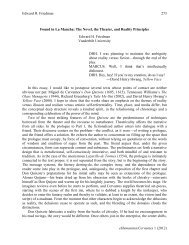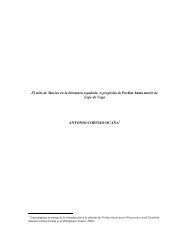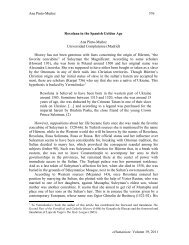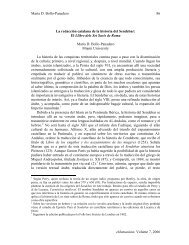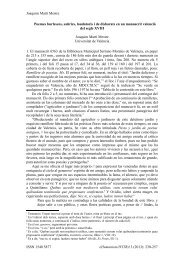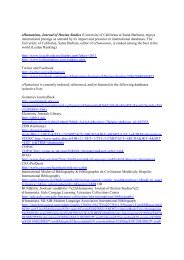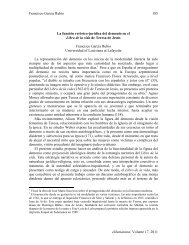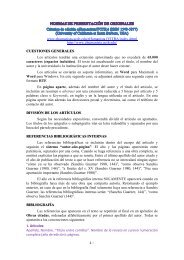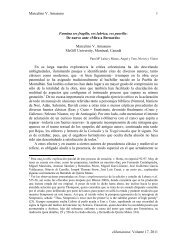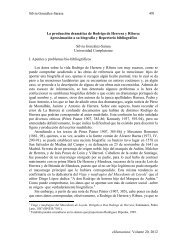Gregory Peter Andrachuk eHumanista: Volume 17, 2011 540 Alonso ...
Gregory Peter Andrachuk eHumanista: Volume 17, 2011 540 Alonso ...
Gregory Peter Andrachuk eHumanista: Volume 17, 2011 540 Alonso ...
You also want an ePaper? Increase the reach of your titles
YUMPU automatically turns print PDFs into web optimized ePapers that Google loves.
<strong>Gregory</strong> <strong>Peter</strong> <strong>Andrachuk</strong><br />
information given earlier in the text (I, 455) that Ramón and “Alfons” are brothers<br />
–but the information on the latter is scarce and there is nothing to identify him<br />
specifically as the <strong>Alonso</strong> de Cardona we seek. One might be forgiven for wanting to<br />
abandon this maddeningly confusing quest. Yet there is one initial fact which might<br />
lead us to a tenable theory: the author of Qüestión de amor must be both an<br />
accomplished poet and prose writer. The only <strong>Alonso</strong> de Cardona who can reliably be<br />
identified as a poet is the one whom Perea Rodríguez (240) names as both Almirante<br />
de Aragón and the poet of the Cancionero General. 20 It is to this person that we must<br />
now turn our attention.<br />
<strong>Alonso</strong> de Cardona, poet and courtier<br />
Among the poets of the Cancionero General fully a third are of the upper nobility<br />
(Boase 3) and many are noted members of the Valencian aristocracy. 21 Estela Pérez<br />
Bosch reminds us that “muchos de los autores que hoy estudiamos como poetas fueron<br />
más conocidos por desempeñar otros cargos, y la mayoría no constan como poetas en<br />
la nómina de la corte” (2). The simple mention of his name in the rubrics to his poems<br />
in the Cancionero General (“Canción de don <strong>Alonso</strong> de Cardona”, “Glosa de don<br />
<strong>Alonso</strong> de Cardona”…) would be sufficient to indicate his identity in a very full sense<br />
for contemporary readers familiar with the court and with current events, obviating the<br />
need of fuller identification: “tuvieron que ser tan familiarmente conocidos que no se<br />
siente la necesidad de dar mayores datos” (Pérez Bosch 5). Because the composition<br />
of poetry was seen as just one of the expected attributes of a courtier, little attention<br />
would be given to <strong>Alonso</strong> de Cardona as poet; much more noteworthy would be the<br />
events of his social, military and political life as courtier, noble and as Almirante de<br />
Aragón. For his contemporaries these roles were much more important in forming<br />
their estimation of him. His role as poet was conventional and subordinate to the more<br />
for the same name during this period, and on occasion both <strong>Alonso</strong> and Alfonso are used to name the<br />
same person. GeneAll.net gives the form “Alfonso” for our subject. As an example of the contemporary<br />
alternation of the forms <strong>Alonso</strong>/Alfonso, Emilia Salvador esteban remarks regarding Alfonso Sánchez,<br />
“Lugarteniente de Tesorero General”: “En la documentación valenciana su nombre aparece<br />
indistintamente como Alfonso o <strong>Alonso</strong>” (712).<br />
20 The identification of the poet <strong>Alonso</strong> de Cardona as Almirante de Aragón had been made earlier by<br />
Martí Grajales (223). Perea Rodríguez errs in calling him Almirante de Valencia, perhaps influenced by<br />
the same error in Gonzalo Fernández de Oviedo. All other sources give the title as Almirante de<br />
Aragón. For the chronology of the Admirals see the Marqués de Laurencín 354-56.<br />
21 Perea Rodríguez is instructive on this point: “Bastantes de los poetas valencianos presentes en el<br />
Cancionero General son miembros de la nobleza del reino, o en última instancia, personas bien<br />
relacionadas con las altas esferas de la ciudad” (229). The connection between the Valencian nobility<br />
and the arts is well known. The court at Valencia of the Duke of Calabria (from 1526) was a<br />
continuation in many ways of the court of Naples, insofar as that was possible after the decimation at<br />
the battle of Ravenna. Among the courtier-poets at Valencia (a group which included many figures who<br />
had been in Naples and indeed who figure in Qüestión de amor) we find <strong>Alonso</strong> de Cardona. See<br />
Marino 8.<br />
549<br />
<strong>eHumanista</strong>: <strong>Volume</strong> <strong>17</strong>, <strong>2011</strong>



